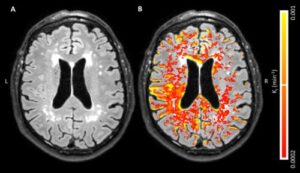Athletes in high-impact sports like MMA, football, and motocross are no strangers to the conversation around brain health. Chronic traumatic encephalopathy (CTE) and other traumatic brain injuries dominate headlines, casting a long shadow over careers and lives. But what if the risk to your brain didn’t just come from visible impacts? What if there was a quieter, more insidious threat—one that doesn’t require a knockout punch or a hard fall to cause damage?
Whether you’re a fighter in the octagon or a sprinter on the track, reaction times, focus, and split-second decision-making are non-negotiable for peak performance. But emerging research suggests that something as pervasive and seemingly innocuous as electromagnetic fields (EMFs) could be compromising your brain’s most critical defense system: the blood-brain barrier (BBB).
The BBB acts as a gatekeeper, protecting the brain from harmful substances in the bloodstream. When it becomes compromised, the consequences can range from reduced cognitive performance to long-term neurological disorders, adding yet another layer of risk to an athlete’s already demanding lifestyle. For those already concerned about the effects of concussions and CTE, this invisible threat could be the ultimate blindside.
EMFs are everywhere—in your phone, your gym’s Wi-Fi, even the Bluetooth headphones you use during training. While they may seem harmless, science is beginning to show how they creep into the body and brain, disrupting natural defenses and potentially paving the way for career-ending issues—or worse, a diminished quality of life after the final whistle blows. Let’s explore the science behind this silent intruder and what you can do to protect your brain for both peak performance and long-term health.
What Is the Blood-Brain Barrier?
The blood-brain barrier (BBB) is a semipermeable membrane that lines the blood vessels in the brain, acting as a gatekeeper between the bloodstream and brain tissue. Comprised of tightly packed endothelial cells, the BBB prevents harmful substances such as toxins, pathogens, and large molecules from entering the brain, while allowing essential nutrients and oxygen to pass through. Supporting cells like astrocytes and pericytes reinforce its function, making it one of the body’s most important protective systems.
The brain, being the body’s command center, requires a stable and controlled environment to function optimally. Any fluctuation in this environment—whether from invading toxins or even small molecular imbalances—can have significant consequences. Cognitive performance, reaction times, focus, and even emotional regulation are all directly linked to the health of the BBB. For athletes, whose performance relies on split-second decision-making and mental sharpness, maintaining the integrity of this barrier is paramount.
However, the BBB isn’t impervious to damage. Factors such as aging, stress, infections, and environmental toxins can weaken its structure. In recent years, researchers have turned their attention to EMFs as a potential disruptor. The emerging evidence suggests that these invisible waves may compromise the BBB in ways that could profoundly affect brain health.
What Happens When the Blood-Brain Barrier Becomes Leaky?

A compromised BBB, often referred to as “leaky brain,” occurs when the tight junctions between endothelial cells loosen, allowing substances that would typically be blocked to pass into the brain tissue. This can trigger a cascade of harmful effects, including neuroinflammation, oxidative stress, and long-term neuronal damage. Leaky brain is associated with several neurological disorders, including Alzheimer’s disease, Parkinson’s disease, and multiple sclerosis, as well as mood disorders like anxiety and depression.
In athletes, a leaky BBB can manifest as cognitive fog, slowed reaction times, and reduced ability to focus under pressure. These symptoms are particularly concerning for athletes in high-stakes sports, where even a momentary lapse in judgment can mean the difference between victory and defeat. But the risks extend far beyond the immediate impact on performance. Over time, chronic BBB disruption could lead to neurodegeneration and a host of other long-term health issues.
The Science Linking EMFs to BBB Disruption
Research into the effects of EMFs on the BBB has yielded concerning findings. One of the most significant studies in this field exposed rats to 915 MHz microwaves, a frequency commonly used in mobile phones. The results showed a marked increase in BBB permeability, with albumin—normally blocked by the BBB—leaking into brain tissue. Specifically, albumin leakage was observed in 56 out of 184 exposed rats, compared to just 5 out of 62 in the control group. This study demonstrated that EMFs can compromise the BBB at exposure levels well below the threshold for thermal damage.
Another study explored the effects of continuous and pulse-modulated electromagnetic waves on the BBB. Both types of exposure were found to increase BBB permeability, challenging the assumption that only thermal radiation poses a risk. This finding is particularly alarming given the prevalence of non-thermal EMFs in everyday environments, from Wi-Fi routers to Bluetooth devices.
The exact mechanisms by which EMFs disrupt the BBB are still under investigation, but several hypotheses have gained traction. One prominent theory is that EMF exposure generates oxidative stress, a condition characterized by an imbalance between free radicals and antioxidants in the body. Reactive oxygen species (ROS), a type of free radical, can damage cellular structures, including the endothelial cells that form the BBB. This oxidative stress not only weakens the cells themselves but also disrupts the tight junctions that maintain the barrier’s integrity.
Another potential mechanism involves voltage-gated calcium channels (VGCCs) in brain cells. EMFs can activate these channels, causing an influx of calcium ions. This influx disrupts cellular signaling and contributes to the breakdown of the BBB. Additionally, the increased calcium levels can trigger neuroinflammation, further exacerbating the damage.
Why Athletes Are Uniquely Vulnerable to EMF-Related BBB Damage
Athletes face a perfect storm of factors that make them particularly susceptible to EMF-induced BBB disruption. First, the environments in which athletes train and compete are often saturated with EMFs. High-tech gyms, stadiums equipped with advanced communication systems, and wearable fitness trackers all contribute to a constant barrage of radiation.
Second, the physical demands of athletic performance place additional stress on the BBB. Intense exercise increases blood flow and metabolic activity in the brain, which could amplify the effects of EMF exposure. Furthermore, the recovery periods following strenuous activity are critical for BBB repair. If an athlete’s recovery environment is filled with EMFs, it could hinder the brain’s ability to restore its protective barrier.
Travel is another significant factor. Athletes who frequently fly are exposed to higher levels of cosmic radiation, and time spent in airports introduces them to additional EMF sources, such as body scanners and Wi-Fi networks. This cumulative exposure adds to the already high levels of radiation they encounter in their daily lives.
The Broader Implications of a Compromised BBB
The consequences of BBB disruption extend far beyond cognitive performance. Chronic inflammation and oxidative stress, both linked to a leaky BBB, are known precursors to neurodegenerative diseases. For athletes, this means that the long-term risks of EMF exposure could include not only cognitive decline but also conditions like Alzheimer’s and Parkinson’s disease.
The mental health implications are equally concerning. Increased permeability of the BBB has been associated with mood disorders such as anxiety and depression. For athletes who already face immense psychological pressure, the added burden of a compromised BBB could exacerbate mental health challenges.
Practical Strategies to Protect the Blood-Brain Barrier
Protecting the blood-brain barrier (BBB) from EMFs requires a combination of proactive lifestyle adjustments and cutting-edge technology. Here’s a comprehensive guide to safeguard your brain and performance:

1. Incorporate Aires Tech for Advanced Protection
- Aires Tech in Action Sports: Aires Tech is partnering with organizations like UFC, NASCAR, and other high-impact sports to help athletes shield themselves from EMFs. Whether it’s inside packed arenas or on the racetrack, athletes use Aires Tech Lifetune products to neutralize harmful electromagnetic waves and protect cognitive function.
- Lifetune Devices: These compact, easy-to-use devices restructure EMF waves into a form less harmful to the body. Attach a Lifetune One to your phone, laptop, or even wireless headphones for 24/7 protection.
- In the Home or Gym: Lifetune Zone units can protect larger spaces, such as your living room, bedroom, or training facility, ensuring you stay shielded even during high exposure times.
2. Forest Bathing, Screen Time Breaks, and Grounding in Nature
Spending time in nature without screens is essential for both mental and physical recovery. Forest bathing (shinrin-yoku), or simply immersing yourself in a natural setting, reduces stress, boosts immune function, and lowers oxidative stress. Cutting down screen time during outdoor activities also limits EMF exposure, helping your brain reset.
Ditch the shoes occasionally to ground yourself by walking barefoot on grass or sand, allowing your body to connect with the Earth’s electrical charge. This simple practice reduces inflammation, promotes better sleep, and complements the restorative effects of time in nature.
3. A Diet Rich in Antioxidants
- Why It Matters: EMFs generate reactive oxygen species (ROS), which cause oxidative stress and damage to cells, including those that make up the BBB.
- What to Eat: Load up on antioxidant-rich foods like:
- Berries (blueberries, raspberries, blackberries)
- Leafy greens (spinach, kale)
- Nuts and seeds (walnuts, flaxseeds)
- Brightly colored vegetables (carrots, bell peppers, sweet potatoes)
- Supplements to Consider: Glutathione, vitamin C, vitamin E, and coenzyme Q10 are excellent antioxidant supplements that can further support BBB health.

4. Smart Use of Technology
- Avoid Holding Your Phone to Your Head: Always use speakerphone or wired headphones when taking calls. If you must use wireless headphones, attach an Aires Tech Lifetune One to the outside of over-the-ear models to reduce EMF exposure near your brain.
- Turn Off Routers at Night: Reduce constant exposure during critical recovery hours by switching off Wi-Fi routers while you sleep.
- Limit Bluetooth and Wireless Use: Whenever possible, opt for wired connections over Bluetooth for devices like keyboards, headphones, and internet access.
Conclusion: Protecting Athletes in an EMF-Saturated World
The evidence linking EMFs to blood-brain barrier disruption is growing, and the implications for athletes are profound. From reduced cognitive performance to increased vulnerability to neurological disorders, the risks cannot be ignored. As technology continues to evolve, so must our understanding of its impact on the human body.
Athletes who take proactive steps to reduce EMF exposure and support their BBB health will not only safeguard their performance but also protect their long-term well-being. The invisible threat of EMFs may be silent, but our response must be loud and clear: awareness, action, and advocacy for a healthier future.







